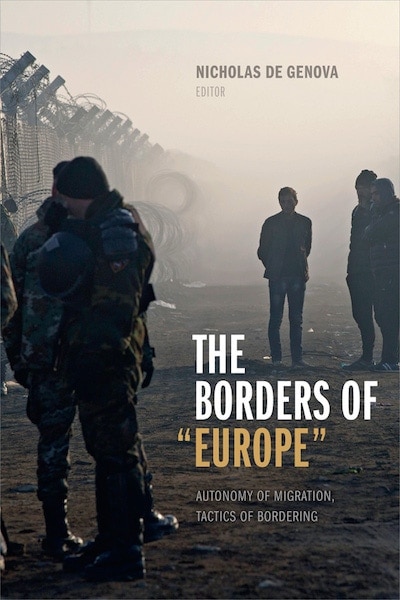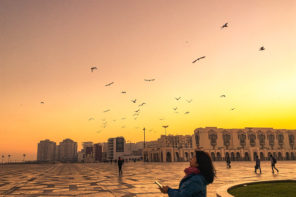In the frenzied media coverage of Europe’s migration “crisis” in recent years, the borders of Europe have been depicted as under attack, desperately in need of securing against the staggering numbers of migrants on the move. As European states modified their border policing tactics, migrants responded in turn, adjusting their routes and strategies in the hope of reaching their destinations. Nicholas De Genova has long argued that one reason why human mobility appears so threatening to state sovereignty is the “sheer autonomy” of migration. It is this interplay – between migrants’ “mobility projects” and state responses – that De Genova pursues in this edited collection.
In The Borders of “Europe”, De Genova brings together eleven chapters in a multi-scalar and wide-ranging examination of the tensions between freedom of movement and the technologies of states seeking to control and limit human mobility. Through the selection and arrangement of these theoretical and ethnographic contributions, and the ideas set out in De Genova’s comprehensive introductory chapter, the collection reveals not only the shifting and dynamic production of the border, but of the very notion of “Europe” itself, as a political, economic and cultural project.
The book sets out to undertake a formidable task in attempting to both track and analyse the various shifts in migratory movements and bordering practices in Europe, during the years of peak irregular migration across the Mediterranean, as well as mass migrations by land into and across Europe.
The chapters in the collection are thoroughly foregrounded by De Genova’s introduction, which provides a critical examination of Europe’s “crisis” and traces the shifts that have occurred in irregular migration in recent years, and the ways in which the border has both expanded outwards through externalisation policies and retracted inwards, as the spaces of asylum have shrunk. De Genova documents the demonisation and criminalisation of refugees and migrants, and key moments which served to heighten the “dangerous” autonomy assigned to migrants – such as the Paris terror attacks, and mob sexual assaults in Germany (p.14-15). He examines the racialised dynamics of these constructions, and locates these within Europe’s colonial history – a critical historicisation which is often absent in the popular migration “crisis” discourse.
The chapters in The Borders of “Europe” stretch across an expansive geography, with ethnographic material drawn from Mali to Latvia, Istanbul to London, and across the Mediterranean with Greece, Rome and Southern Italy represented, alongside Tunisia and Melilla in North Africa.
It is notable – and perhaps commendable – that many of the contributors are PhD candidates, postdoctoral fellows, or other early career researchers. Their research is therefore the result of sustained fieldwork undertaken at the height of the “crisis,” with several of the contributors being actively involved in migrant solidarity projects.
In chapter one, “’The Secret is to Look Good on Paper’: Appropriating Mobility within and against a Machine of Illegalization” Stephan Scheel lays out the ways in which the border regime produces migrant illegality, masked behind the spectacle of border enforcement. He argues that from the point of applying for a visa, the Schengen visa regime creates an “artificial scarcity of access to mobility to Europe by setting visa requirements that do not correspond to local circumstances” and therefore “entices applicants to engage in criminalised practices” such as document fraud (p.60). In their “performances of docile compliance,” migrants subvert and appropriate the rules and criteria that seek to deny them mobility. They script themselves as credible mobile subjects, thereby undermining bureaucratic “risk assessment” practices.
Other chapters – including those by Ruben Andersson, Charles Heller and Lorenzo Pezzani, and Laia Soto Bermant – examine the Mediterranean, the spectacle of bordering practices, and the increasing entanglement of security, economic, and humanitarian interests involved in the performance of border policing.
They situate humanitarian imperatives within a larger assemblage of migration control, where “rescue” is often used as a justification for interceptions.
Andersson’s chapter “Rescued and Caught: The Humanitarian-Security Nexus at Europe’s Frontiers” demonstrates the role of humanitarianism in contributing to a self-perpetuating “illegality industry” at the borders (p.67). Heller and Pezzani argue in “Liquid Traces: Investigating the Deaths of Migrants at the EU’s Maritime Frontier” that despite the high degree of surveillance of the Mediterranean maritime space, the EU routinely engages in lethal acts of non-assistance to vessels in distress as a tactic of bordering. By looking at surveillance data with a “disobedient gaze,” they have been able to expose and challenge deadly violations at sea (p.110). Bermant’s chapter on the Spanish enclave of Melilla shows us that we must move beyond traditional understandings which pit mobility against restriction, and instead consider the economic interests at stake in the openings and closing of borders, and the forms of selective border permeability that exits, despite the apparent reinforcements.
Five chapters in the collection draw upon migrant experiences and perspectives in diverse localities, to paint a picture of migrant autonomy, planning, resilience and claim-making, alongside pervasive experiences of fear, trauma, waiting and insecurity. Clara Lecadet focuses on expelled migrants’ self-organising in West Africa and the politicisation that can arise from the experience of being deported. The role of the humanitarian regime in bordering enforcement is further critiqued by Glenda Garelli and Martina Tazzioli in their chapter about Choucha – a refugee camp in Tunisia along the Libyan border, which officially no longer exists. Former asylum seekers living in the “camp after the camp” have been abandoned as humanitarian subjects, and so undertake diverse strategies to further their mobility projects beyond the various forms of capture (p.183).
Souad Osseiran’s chapter on Syrians in Istanbul and Maurice Steel’s chapter on Syrians in Greece both draw upon ethnographic fieldwork with migrants in transit, who are seeking to move towards and within Europe.
Beyond the official information and political boundaries, migrants share with one another their own information and perspectives on their destinations, which offer various degrees of precarity and permanence, to create alternate imaginings of “Europe”. The examination of the European asylum framework – the Dublin regulation – by Fiorenza Picozza utilises ethnographic fieldwork with Afghanis in London and Rome to show how migrant illegality and refugeeness is socially and legally produced, leaving many “with tentative forms of legality.” Many “Dubliners” remain stuck in transit, moving from one country to another for years. Picozza demonstrates the ongoing affective, embodied and existential impacts of being “Dublined” on those who seek to cross borders, even long after their arrival (p.250-252).
The final two chapters raise, amongst other issues, the role of the “citizen” in relation to the foreigner, the refugee, the migrant. Evelina Gambino explores a campaign for fairer work conditions, emerging out of a migrant settlement in the heart of the food bowl in southern Italy, which became a regional centre for recruiting cheap labour. She examines the intersections of capital and migration control, and raises issues of fair labour, politicisation, solidarity models, and reflections on militant or activist research. In stark contrast to these solidarity projects, Dace Dzenovska in her chapter “‘We want to Hear from You’: Reporting as Bordering in the Political Space of Europe” traces the ways in which European citizens become enlisted in everyday practices of bordering through practices of reporting on suspected foreigners in irregular visa conditions. Dzenovska analyses these reporting practices as a technology of government by late liberal democratic states, where state power is obscured while citizens do the work of policing and surveillance.
The Borders of “Europe” draws upon diverse localities and contexts to bring together a picture of Europe’s borderscape, where migrants’ autonomous mobility comes up against the bordering practices of states and their collaborators, including private agencies, humanitarian actors, and everyday citizens. The collection manages to stitch together diverse ethnographic sites, lived experiences, and critical analysis to illustrate the ways in which the border has become a key site for defining and contesting the very meaning of Europe.
References:
De Genova, Nicholas and Peutz, Nathalie. 2010. The Deportation Regime: Sovereignty, Space, and the Freedom of Movement. Durham: Duke University Press.
Featured image by hans wakataitea (flickr, CC BY 2.0).










